Table of contents
- Comparison test: BMW R 1200 GS, Ducati Hypermotard 1100 S, KTM 990 Supermoto Play boys!
- Play boys!
- Play instinct
- Nothing to slow down the fun
- Measurements and chassis tip Ducati
- Punch & Puncher
- Data BMW R 1200 GS
- Data Ducati Hypermotard 1100 S
- Data KTM 990 Supermoto
- reviews
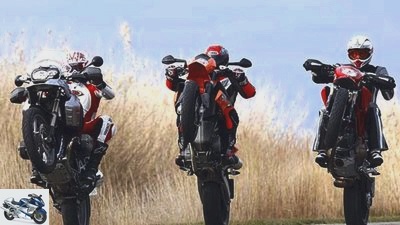
Jahn
motorcycles
Comparison test: BMW R 1200 GS, Ducati Hypermotard 1100 S, KTM 990 Supermoto
Comparison test: BMW R 1200 GS, Ducati Hypermotard 1100 S, KTM 990 Supermoto
Play boys!
Content of
“Don’t worry, they just want to play.” Are you kidding me? Are you serious when you say that! Do you want to bite? and properly! Two proven fun bikes, the Ducati Hypermotard 1100 S and the KTM 990 Supermoto as well as the established and renovated universal genius BMW R 1200 GS form our trio Infernale. Where they dance the curve parquet, the air burns; the eyes light up, and the danger of indulging in one’s own playful instinct is omnipresent.
Robert luck
03/12/2008
Play boys!
No, it’s not unfair: the one roughly outlined as a travel enduro R 1200 GS must against the two sharply defined jester specialists Ducati Hypermotard 1100 S and KTM 990 Supermoto compete. After all, the BMW has occupied the throne of all-rounders for ages and was gently but purposefully redesigned for model year 2008: It got the more powerful engine from the R 1200 R, and the suspension strut set-up, which PS always criticized as being far too soft, was changed. So please, then show what you can do, you rolling pocket knife. As usual, BMW sends its test candidate to the start as a full dresser, in other words: equipped with every imaginable bells and whistles from the list of accessories and surcharges. This of course includes the ABS that can be switched off (very useful), the electrohydraulically adjustable ESA chassis (useful) and a type of traction control that BMW internally describes as a starting aid on slippery surfaces: the Automatic Stability Control ASC (not useful at all).
The simply knitted traction control records the wheel speeds via the ABS sensors and reduces ignition and injection in normal mode at a speed difference of around 10 km / h between the front and rear wheels. In off-road mode, the system only regulates from a difference of 60 km / h, so it allows significantly more slip. It works very roughly, of course also prevents wheelies and in normal mode on warty asphalt does not get out of the control range. While Hypermotard and Supermoto happily whirl through the labyrinth of curves on the smallest country roads, the GS snobs and mocks behind lonely. You have to switch off the ASC so that it can keep up and show off its more tightly tuned chassis.
The driving impression on the BMW is an old acquaintance: The world tour boxer embeds its pilot very passively in the vehicle, the Telelever delivers zero feedback from the front wheel, and the slim tires and the very wide handlebars ensure acceptable handling. The fact that the steering head angle was 1.4 degrees steeper for the 2008 model year, the caster 9 and the wheelbase 6 millimeters shorter, is only noticeable in a direct comparison with a 2007 model.
On the other hand, the shock absorber, which has finally been dampened tighter, catches the eye or the buttocks: In the ESA “Normal” mode, you can now heat up wonderfully. The rear wheel starts to stomp out of the lane much later than on its predecessor, but it still goes on a block every now and then. The “Sport” mode, however, is only suitable as a countermeasure on flat surfaces; On undulating slopes, it tends to increase the tendency towards stamping. Speaking of “reinforced”: The horse crowd in the boxer stable became that too. It should now accommodate 105 hp, 7 more than the previous year’s model. Above all, this increase has sharpened the performance peak and shifted it to higher speeds; because the overall gear ratio has also become shorter, the R 1200 GS now starts running from 6500 rpm like a bargain hunter in the sale.
Play instinct
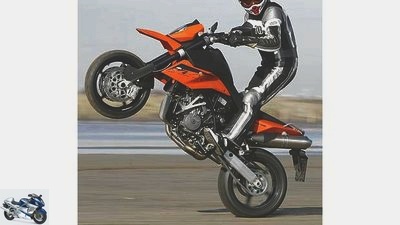
Jahn
The joker par excellence. The driver’s license has seldom been in acute danger.
However, the speed level is unusually high: at 120 km / h there are already 4300 rpm. Overall, the new, more pointed engine characteristics fit less well with the overall concept of the GS; as a tourer, their beefy torque would be better. If you want to achieve top performance in compliance with the Funbike, you can only use the fine line between 6500 / min and the limiter at 8000 / min and have to let the shifter dance diligently. The GS is not alone with such a conceptual flaw: The Hypermotard also plague birth defects. Their radical optics and the extreme positioning of the pilot – you feel as if you were crouching directly on the head tube – do not at all match the air-cooled revolver and the messed up basic set-up of the landing gear. The 1100 Desmo V2 starts like the GS drive should actually start: very smoothly, extremely cultivated and with a big punch from the lower speed range. The two-valve engine pushes forward like a bull from almost 3000 rpm, provokes leaning wheelies in tight, undulating corners, and when accelerating at the corner exit it is the power par excellence.
Thanks to sporty tires and good mechanical grip, the Hypermotard pulls the other two away from the apex of the curve. Unfortunately, this advantage does not last long, because just over 6000 tours is the end of fun, and the twin is tough. The only thing that helps here is to quickly move up to the next gear in the gnarled gearbox in order to be able to continue enjoying the powerful forward thrust. The undercarriage pours out more trouble over the Hyper-Flyer: The factory set-up is – to put it mildly – just good enough that you don’t throw a match in the tank. The Duc falls into an ultra-handy lean position when turning, but then only waits for the driver to be careless for a moment before folding the front wheel. She takes bumps in the sloping position as an opportunity to stand up massively; then the driver has to use strong will and physical pressure to keep them on course.
The shock absorber can handle sporty gaits quite well; however, the fork dips too deeply when braking. In order to have a chance against the attacks of the BMW, the Ducati must first be thoroughly rebuilt (see box on p. 25). Although these measures help the Duc on its way, they do not change the basic problems that it costs its pilots a lot of strength and takes a long time to get used to. They do not require any warm-up phase KTM 990 supermoto. For the Oranges it is the most important two-cylinder model, the link between the old off-road and the new road customers. This balancing act has already been achieved with the carburettor-equipped 950, the success of which the 990, which is equipped with an injection system, is supposed to build on.
The connection should be successful: the pilot slides smoothly onto the seat, the pegs and the handlebar ends receive his extremities. Tap on! This is exactly how a fun bike has to go: direct, spontaneous, snappy and powerful. The Oschi is a turner, not a pusher like the Duc’s Desmo and certainly not an I-don’t-know-what-I-am like the BMW boxer. HOT, what a wonderful sports engine. Casual pressure from idle, combined with an ultra-spontaneous, actually already hard throttle response, a great center, and from 5500 revolutions the fire blazes in the tubular cage. A subtle tip on the gear lever is all it takes for the smooth transmission to rearrange the gear wheels. The clutch is easy to operate and can be dosed like a dream. Braking and turning – just as easy; everything happens as if it was shaken off the wrist.
Nothing to slow down the fun
The super motorist guides the 990 through the bends with ease on the handlebars. The easy folding is followed by neutral directional stability even in the deepest inclined position, which can not be deterred by violent bumps. The chassis components from WP are relatively soft and do not respond brilliantly, but the KTM unmoved swallows almost everything that the surface has to offer in terms of bumps. However, the search for limits also brings results, as stunt and test driver Jo “the German oak” Bauer shows: He forces the shock absorber to its knees or to the stop. And even slightly lighter test drivers succeed in doing this, which throws a delicate shadow over the taker qualities of the rear shock. However, the test drives really did not save on full load.
Another reproach for the KTM: it could always keep the BMW and the Ducati behind, but never leave them behind. And for that she swallowed 10 percent more fuel: 7.9 liters per 100 kilometers through the Bavarian injection, 8.1 through the Italian – and a whopping 8.7 through the Austrian. It’s pretty tough how much the stoves burn when the rider is in a hurry or wants to be. The braking systems of the play mobiles are also heavily designed. The partially integral ABS of the BMW is an ingenious stopper in the wet and on dirty roads. Under such adverse, unpredictable conditions, the cow knocks its hooves into the ground so massively that it almost dislocates your lower jaw – and without the risk of overbraking a wheel.
Unfortunately, things look completely different with the Hypermotard. It is equipped with the 1098 monoblock brake calipers, milled from solid, which are not exactly squeamish: one finger on the hand lever is enough to always have the Hym under control. However, the braking force builds up so suddenly, the initial bite is so poisonous that the insensitive, responsive fork immediately shrinks deeply. What a) initially surprises the pilot, b) increases the risk of overbraking the front wheel and c) is a nerve-wracking thing in an inclined position; after all, the Ducatista has enough to do with not letting the front wheel fold away. It doesn’t look much better on the hindquarters: The rear stopper is difficult to dose, and it is also toxic, which often makes the rear rubber howl.
The KTM shows once again how it can be done better. Your Brembos go to the front vehemently, but not excessively toxic, the braking power can be finely measured and applied gently. This gives the fork a chance to oppose the braking force. On the rear wheel, however, it is also very snappy, the controllability is not at the top level. On the other hand, the visible processing quality of all three motorcycles can be found on this one: surface quality, gap dimensions, the guidance of the Bowden cables and the welded seams are everywhere. However, if the bargain at this event, the KTM 990 Supermoto, tears a 11,595-euro plus additional costs hole in the cash register, then one can expect that too.
Conclusion: A clear victory for the 990 KTM; it offers a magnificent engine in a well-balanced overall package without serious defects. The half-baked Ducati Hypermotard doesn’t stand a chance; the engine, which is not bad at all, cannot compensate for the deficits in the chassis and set-up. The tightened GS impresses: It goes with the proper speed of the two real attackers, but sacrifices a good deal of aggressiveness in favor of its touring qualities. We take off our hats because the cow has learned to fly.
Measurements and chassis tip Ducati
The KTM draws an exemplary curve on paper – that’s exactly how it drives. The Ducati ends its increase in performance at 6000 rpm and lets its pilot feel it. Regarding BMW: Large fluctuations in performance over several measurements indicate that the cylinder-selective knock control intervenes in the engine management system more often than necessary, thus reducing performance. BMW promises to respond with a new injection software. It should be delivered as soon as possible.
Chassis tip Ducati
The Hypermotard 1100 S likes to fold the front wheel in the standard trim. The tire, Pirelli Diablo Corsa III, can’t help it; The only remedy is to convert the chassis. Here’s how: Loosen the fork sliding tubes and push them down until their covers are flush with the upper fork bridge (see picture). Then adjust the spring base to a maximum of minus three turns. Open the rebound stage two turns, the compression stage too. Lower the stern as far as possible (push rod short); Make sure that the shock absorber does not touch the tank when it is deflected, otherwise it can damage it. Leave the spring base at the rear as standard, open the compression and rebound stages 12 clicks each.
Punch & Puncher
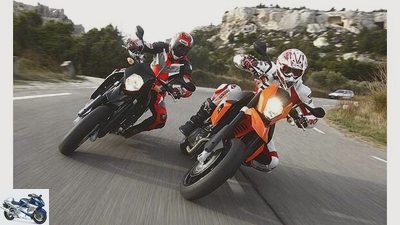
Jahn
PS sent the two power sumos into the ring. Can the 990 be beaten by its predecessor?
When the KTM 950 Supermoto unpacks the hammer, nothing and nobody can stop it. Except maybe her successor. PS sends the two power sumos into the ring.
When the KTM 950 Supermoto thundered onto the market in 2005, the scene gasped. 2 cylinders, 98 HP, 94 Nm – the world of transverse drivers did not know such values until then.
After a good three years of construction, the Austrians removed the 943 cm3 heart of the carburettor from the Supermoto and replaced it with the injection counterpart of the 2007 Super Duke. Means: 115 PS and 97 Nm. That is 17 wild stallions and 3 Nm more than before. KTM explains the difference in performance to the Super Duke (120 hp) with different exhaust systems. Other deviations between Supermoto and Super Duke: the mapping of their ignition / injection systems and the gearbox. The gearbox of the KTM 990 Adventure is in the 950 and 990 Supermoto. The primary drive and final transmission of both sumos are also identical.
The differences between the old and the new Supermoto are noticeable in practice: The 990 hangs ultra-directly on the gas, pushes through the rev range in no time at all and without taking a breather. The range between approx. 5500 rpm and the locking speed (9500 rpm) prepares the most mood. There, the cultivated thousand generates so much lard that the front wheel clicks into the sky even in second gear without any tricks with the clutch; a lot of fun to wheel the 990 out of the corners.
The 950 can’t quite keep up with this exercise. Although it also pushes properly, in a direct comparison it develops its performance much more slowly. Your advantage: you accelerate very gently.
To the chassis. With the exception of harder fork springs, the 990 takes on the same chassis and dampers as its predecessor. The Mattighofener only increased the spring base of the rear damper so that the rear is about 5 millimeters higher. This results in a steering head angle that is 0.5 ° steeper. In order not to shorten the caster (110 mm), the fork bridges have 2 millimeters less offset.
When it comes to the chassis, too, the pilot notices significant differences when it comes to onions. Despite having the same tires (Pirelli Scorpion Sync), the new one sticks much more readily into the corner and can be – whiz, whiz, whiz – shooed quickly; the 1 kg lighter 950er looks a bit more sedate.
The new tank-seat combination of the 990s allows your jockey to move far forward. He sits very actively and has his base perfectly under control at all times with the slightly narrower and higher handlebars. Another difference: the KTM 990 supermoto is around 600 euros more expensive than its predecessor.
Data BMW R 1200 GS
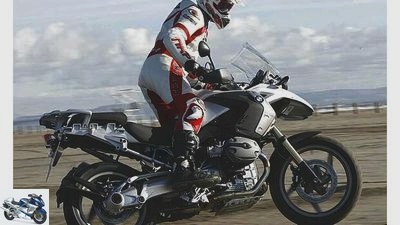
Jahn
There the cow flies. The BMW R 1200 GS can do everything, especially touring, but also fun.
Drive:
Two-cylinder boxer engine, four valves / cylinder, 77 kW (107 hp) at 7000 / min *, 115 Nm at 5750 / min *, 1170 cm3, bore / stroke: 101.0 / 73.0 mm, compression ratio: 12.0 : 1, ignition / injection system, 47 mm throttle valves, hydraulically operated single-plate dry clutch, six-speed gearbox, G-Kat
Landing gear:
Load-bearing engine-gearbox assembly with steel tubular subframe, steering head angle: 64.3 degrees, caster: 101 mm, wheelbase: 1507 mm, Telelever, Ø inner tube: 41 mm, electro-hydraulically adjustable spring base and rebound damping, central spring strut, spring base and Adjustable rebound damping, spring travel from / h .: 190/200 mm
Wheels and brakes:
Light alloy cast wheels, 2.50 x 19 “/ 4.00 x 17”, front tires: 110/80 H 19, rear: 150/70 H 17, initial tires: Bridgestone Battlewing 501/502, 305 mm double disc brakes with four-piston fixed calipers front, 265 mm single disc with two-piston floating caliper at the rear, ABS and ASC
Measurements and weight:
Length / width / height: 2250/950/1390 mm, seat / handlebar height: 850/1140 mm, handlebar width: 835 mm, 244 kg fully fueled, v./h .: 50.0 / 50.0%
Rear wheel power in last gear: 75.2 kW (102 PS) at 216 km / h
Driving performance:
Acceleration 0–100 / 150/200 km / h: 3.6 / 6.7 / 16.8 s
Pulling speed 50–100 / 100–150 km / h: 5.0 / 5.2 s
Top speed: 213 km / h *
Consumption:
Fuel type: Super unleaded, average consumption: 7.9 liters, tank capacity (of which reserve): 20.0 / 4.0 liters, range: 253 km
Price: 15980 Euro (plus ancillary costs) **
Data Ducati Hypermotard 1100 S
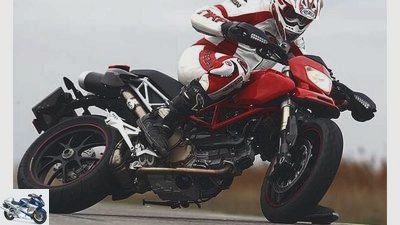
Jahn
The lively Italian is really fun up to 6000 rpm.
Drive:
Two-cylinder V-engine, two valves / cylinder, 66 kW (90 PS) at 7750 / min *, 103 Nm at 4750 / min *, 1079 cm3, bore / stroke: 98.0 / 71.5 mm, compression ratio: 10, 5: 1, ignition / injection system, 45 mm throttle valves, hydraulically operated multi-plate dry clutch, six-speed gearbox, G-Kat
Landing gear:
Steel space frame, steering head angle: 66.0 degrees, caster: 100 mm, wheelbase: 1455 mm, upside-down fork, Ø fork inner tube: 50 mm, adjustable in spring base, compression and rebound, central spring strut with lever system, spring base, compression and rebound damping adjustable, spring travel v./h .: 165/141 mm
Wheels and brakes:
Forged light alloy wheels, 3.50 x 17 “/5.50 x 17”, front tires: 120/70 ZR 17, rear: 180/55 ZR 17, first tires: Pirelli Diablo Corsa III, 305 mm double disc brakes with four-piston fixed calipers at the front, 245 -mm single disc with two-piston fixed caliper at the rear
Measurements and weight:
Length / width / height: 2140/1200/1160 mm, seat / handlebar height: 845/1080 mm, handlebar width: 760 mm, 196 kg fully fueled, v./h .: 47.1 / 52.9%
Rear wheel power in last gear: 60.3 kW (82 hp) at 229 km / h
Driving performance:
Acceleration 0–100 / 150/200 km / h: 3.6 / 7.6 / 18.5 s
Pulling speed 50–100 / 100–150 km / h: 5.6 / 5.7 s
Top speed: 215 km / h *
Consumption:
Fuel type: Super unleaded, average consumption: 8.1 liters, tank capacity (of which reserve): 12.4 / k. A. liters, range: 153 km
Price: 13,245 euros (plus utilities)
Data KTM 990 Supermoto

Jahn
The queen of street surfing: KTM 990 Supermoto.
Drive:
Two-cylinder V-engine, four valves / cylinder, 85 kW (116 PS) at 9000 / min *, 97 Nm at 7000 / min *, 1000 cm3, bore / stroke: 101.0 / 62.4 mm, compression ratio: 11 , 5: 1, ignition / injection system, 48 mm throttle valves, hydraulically operated multi-plate oil bath clutch, six-speed gearbox, G-Kat
Landing gear:
Steel space frame, steering head angle: 65.1 degrees, caster: 110 mm, wheelbase: 1510 mm, upside-down fork, Ø fork inner tube: 48 mm, adjustable in spring base, compression and rebound damping, directly hinged central spring strut adjustable in spring base, pressure – and rebound damping, spring travel v./h .: 200/210 mm
Wheels and brakes:
Cast light alloy wheels, 3.50 x 17 “/5.50 x 17”, front tires: 120/70 ZR 17, rear: 180/55 ZR 17, first tires: Pirelli Scorpion Sync, 305 mm double disc brakes with four-piston fixed calipers at the front, 240 mm single disc with two-piston floating caliper at the rear
Measurements and weight:
Length / width / height: 2170/870/1350 mm, seat / handlebar height: 875/1145 mm, handlebar width: 745 mm, 208 kg fully fueled, v./h .: 49.0 / 51.0%
Rear wheel power in last gear: 81 kW (110 PS) at 244 km / h
Driving performance:
Acceleration 0–100 / 150/200 km / h: 3.7 / 6.5 / 11.9 s
Pulling speed 50–100 / 100–150 km / h: 5.5 / 5.3 s
Top speed: 220 km / h *
Consumption:
Fuel type: Normal Super, average consumption: 8.7 liters, tank capacity (of which reserve): 19.0 / 2.5 liters, range: 218 km
Price: 11595 Euro (plus utilities)
reviews
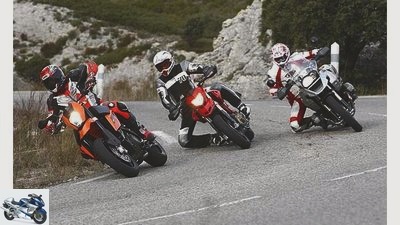
Jahn
Victory today is orange. The KTM does the best with 18 points.
BMW R 1200 GS
Drive:
The great tuning of the boxer doesn’t fit the balanced concept of the GS at all. What looks good on an HP2 looks out of place in the GS.
landing gear
Its tighter basic setup definitely makes the GS faster. The ESA continues to inspire them, but the rear wheel occasionally tramples off the track when the heater is heated.
ergonomics
Here the GS is punished for their tourist qualities. The seating position is too passive, the Telelever does not convey a feeling for the front wheel.
Driving fun
The BMW would be better able to face an engine like the Duc-Desmo. But although sedate, it can be taken really hard for heating.
verdict
The GS can do almost anything. However, when things really get down to business like here on the country road, their 44 kg excess weight becomes a noticeable burden.
3rd place / 13 points
Ducati Hypermotard 1100 S.
drive
It has pressure from below and, thanks to mechanical grip, is the quickest out of the corner. It gets very tough around the top, but the Desmo is extremely cultivated.
landing gear
One word: unbalanced. After the conversion the Duc still falls in an inclined position, but still has to be held there with pressure.
ergonomics
Emotionally, the pilot sits directly on the front wheel. Unfortunately, the handlebars are a little too close to him and a touch too deep. Otherwise it’s okay.
Driving fun
The Hym is really fun up to 6000 rpm. On undulating, narrow stretches, however, their erection moment is annoying. It demands a lot of strength from its pilot.
verdict
The Hym has a suspension problem that can only be alleviated quickly, but not solved. Pity; with a better setting it would be a blast.
2nd place / 14 points
KTM 990 Supermoto
drive
The KTM twin almost got five stars because it chisels a grin on your face. But consumption and responsiveness require deductions.
landing gear
Despite the soft basic setup, the KTM is completely convincing. Unfortunately, the shock strut often punctures when it burns, a deflection is simply missing.
ergonomics
There’s nothing better for street surfing than sumo! Everything fits perfectly, even the 19 liter tank doesn’t bother, and the operating force of the levers is fantastic.
Driving fun
The almost perfect overall package makes the KTM the superior clown in this arena. There is no bad mood for you and your driver.
verdict
It is a hunting dog, mood cannon and lap dog in one. She can even drive slowly, but she never wants to! This is what a winner in the fun bike test looks like.
Place 1/18 points
Related articles
-
Comparison test Ducati Hypermotard old against new
Artist 22nd pictures jkuenstle.de 1/22 Ducati Hypermotard 1100 Evo (old) and Ducati Hypermotard 821 (new). jkuenstle.de 2/22 Ducati Hypermotard 821….
-
Ducati Monster 1100, Moto Guzzi 1200 Sport
Jahn 30th pictures Markus Jahn 1/30 In PS 4/2009, the Moto Guzzi 1200 Sport (left) and the Ducati Monster 1100 met for a comparison test. Markus Jahn…
-
Comparison test Ducati 1098S, Honda Fireblade, KTM 1190 RC8, Triumph Daytona 675, Yamaha YZF-R6
Jahn motorcycles Comparison test Ducati 1098S, Honda Fireblade, KTM 1190 RC8, Triumph Daytona 675, Yamaha YZF-R6 Comparison test Ducati 1098S, Honda…
-
Bilski motorcycles Comparison test: KTM 990 Super Duke, Moto Morini Corsaro 1200 Veloce, Triumph Speed Triple, Yamaha FZ1 Comparison test: KTM 990…
-
Top test Ducati Multistrada 1100
Gargolov motorcycles Top test Ducati Multistrada 1100 Top test Ducati Multistrada 1100 Turboprop Clear the start for the greatest air-cooled Ducati of…
-
fact 15th pictures Ducati 1/15 Ducati Hypermotard SP. Ducati 2/15 Ducati Hypermotard SP. Ducati 3/15 Ducati Hypermotard SP. Ducati 4/15 Ducati…
-
Comparison test Ducati Monster 1200 S, Honda Fireblade, Kawasaki Z 1000 SX, Suzuki GSX-S 1000 F
jkuenstle.de 27 pictures jkuenstle.de 1/27 The disguised Suzuki GSX-S 1000 F has to prove itself in the field of competitors. jkuenstle.de 2/27 Nice is…
-
Comparison test: 600cc extreme athlete
K motorcycles Comparison test: 600cc extreme athlete Comparison test: 600cc extreme athlete Spear tips Content of They flaunt long lances at the end, are…
-
Comparison test: 600s in a quintet
Jahn motorcycles Comparison test: 600s in a quintet Comparison test: 600s in a quintet Toys Content of The middle class is burning brightly! The…
-
Comparison test: 10 supersport bikes
K motorcycles Comparison test: 10 supersport bikes Comparison test: 10 supersport bikes Time fuse Content of Verbal infight in the editorial office: “The…